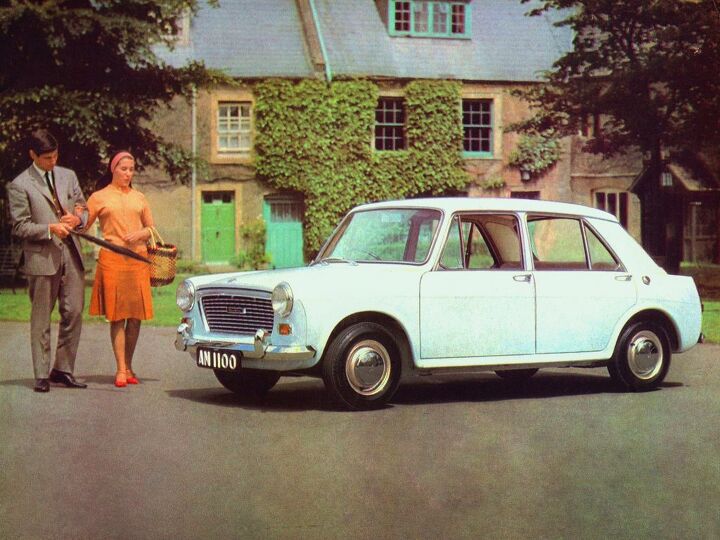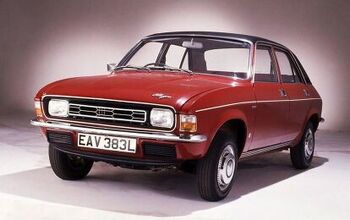Abandoned History: The Austin Allegro Story, a Fine Motorcar (Part I)

Today we embark on the story of the small British car made famous long after its demise by a certain BBC car program. It was ugly, poorly made, and had a nasty reputation while it was still on sale. We're speaking of course about the Austin Allegro. Prepare yourself for the forward-looking new car from British Leyland.
The Allegro was an important car for Austin and its amalgamated parent British Leyland and was one of the first product designs generated by the new company after it was founded in early 1968. Of the 17 total automobile marques within the BL portfolio, Austin was a full-line manufacturer of middle-market cars, sort of like Rover (the brand that eventually absorbed it).
Designed for the important small family car consumer, the Allegro was a replacement for the ADO16. Most often known as the Austin 1100 or Morris 1100, it was also sold in various badge-engineered versions from MG, Riley, Vanden Plas, and Wolseley. The ADO16 was a hatchback-shaped sedan, available in two- and four-door versions, as well as a wagon.
The 1100 was designed by Sir Alec Issigonis, who brought the world the Mini in 1959. All ADO16 variants were produced between 1962 and 1973, though some were killed off a bit earlier. The practical cars used A-series Austin engines from the Fifties, and though the model was very successful it looked dated by the turn of the Seventies, and competition from other brands had more updated product.
British Leyland knew it needed to move away from multiple badge-engineered versions of the same car, and the new Allegro would be marketed under only two BL marques: Austin and a few years later, Vanden Plas. The latter turned the Allegro into a “luxury” car, as was the brand’s mission (more on that in the future).
Allegro was offered alongside two similar cars from BL, largely differentiated by their body styles. The first to arrive was the Maxi, a slightly larger five-door hatchback. Maxi was the first British five-door hatchback design, and the last car designed at BMC before it was reorganized as British Leyland.
It was intended to be available as a sedan as well, but BL management canned that project and instead had Morris offer the Marina as a sedan in 1971. The Marina shared a 96-inch wheelbase with the Allegro but was more traditional and rear-drive. The front-drive Allegro was the last of the trio to arrive, in 1973.
Internally the Allegro project was known as ADO67 and began in 1968 when British Leyland was less than a year old. The original intention at BMC was a modernization of the Austin 1100 design, a program known as ADO22. BL management killed that idea and stated that an all-new car was needed to compete with the successful Mark II Ford Cortina. Part of the all-new car idea was in order to support branding differentiation: Austin would sell more adventurous car designs, while Morris would appeal to the more traditional buyer.
And adventurous was what the Allegro’s original designer, Harris Mann, envisioned. The late Sixties and early Seventies styling trend was toward sharper, squared-off angles and wedge designs. Mann penned a two-door sedan shape that was sharp and wedge-like. As the illustration shows, a low hood line met with a front fascia that was angled forward and held a thin chrome bumper.
Side detailing relied mostly on a nearly horizontal character line, with a minimum of detailing. Mag-type wheels lent a sporty look, and a fast A-pillar met an equally fast C-pillar at the Allegro’s rear. It almost looked like something AMC would envision under the guise of Dick Teague; even the door handle design was AMC-like.
It was a modern take on the 1100’s successful design - the original prompt from management. However, while the design looked great there were some issues with its implementation. BL demanded that although it was a new car, the Allegro must have as many extant parts as possible. Most important among those was engine sharing.
Austin planned to continue the use of the A-Series inline-four engines from the 1100, all of which were smaller displacements. However, BL management stated the E-Series engine must also fit under the hood as it would power more upscale versions of the Allegro, and later on in the Vanden Plas. E-Series engines were larger and taller than the A-Series mills, and in this instance were 1.5 and 1.7 liters in displacement.
Fighting for the limited room with the engine was a newly developed (and large) heating system. It was a sunk cost and already implemented in the new Marina. Management said it had to be used on the Allegro too. Both things forced Mann to redesign the hood line to be much higher than intended. And that had consequences with regard to the greenhouse and meant less glass.
Sharp edges and the wedge design were removed shortly thereafter by engineers, who had recently spent time with a design intended as a replacement for the Mini. So-called "Barrel Car" project focused on new packaging methods and structural strength via rounded panels.
In the end, engineers and management at BL transformed Mann’s design into something much less than sleek. It was only then that the design was presented to management in 1969 for approval, among five total design options. It was given the green light for production and received few design changes from that point forward.
Rounded corners and a general curvature of all panels combined with a roof that was taller and more conservative than originally intended. The front end used headlamps already available in the BL parts bin, which made for a dowdy front end that lacked any sportiness.
The look was completed with some steel wheels and hubcaps, and the Allegro looked like it sat slightly too high because of its gas suspension (more on that later). Overall, the Allegro looked much softer than intended because of its roundness and looked too tall with its shrunken glass area. It was a sort of adventurous design because it was the opposite of all popular contemporary styling.
None of that mattered to British Leyland management, who were determined that this new styling direction on the Allegro would mesh perfectly with its up-to-date engineering and create a truly timeless design. Next time we’ll discuss said engineering, where BL management and engineers mixed 1950s mechanicals with advancements in gas suspension technology.
[Images: British Leyland]
[Allegro project detail: AR Online]
Become a TTAC insider. Get the latest news, features, TTAC takes, and everything else that gets to The Truth About Cars first by subscribing to our newsletter.

Interested in lots of cars and their various historical contexts. Started writing articles for TTAC in late 2016, when my first posts were QOTDs. From there I started a few new series like Rare Rides, Buy/Drive/Burn, Abandoned History, and most recently Rare Rides Icons. Operating from a home base in Cincinnati, Ohio, a relative auto journalist dead zone. Many of my articles are prompted by something I'll see on social media that sparks my interest and causes me to research. Finding articles and information from the early days of the internet and beyond that covers the little details lost to time: trim packages, color and wheel choices, interior fabrics. Beyond those, I'm fascinated by automotive industry experiments, both failures and successes. Lately I've taken an interest in AI, and generating "what if" type images for car models long dead. Reincarnating a modern Toyota Paseo, Lincoln Mark IX, or Isuzu Trooper through a text prompt is fun. Fun to post them on Twitter too, and watch people overreact. To that end, the social media I use most is Twitter, @CoreyLewis86. I also contribute pieces for Forbes Wheels and Forbes Home.
More by Corey Lewis
Latest Car Reviews
Read moreLatest Product Reviews
Read moreRecent Comments
- 28-Cars-Later I'm getting a Knight Rider vibe... or is it more Knightboat?
- 28-Cars-Later "the person would likely be involved in taking the Corvette to the next level with full electrification."Chevrolet sold 37,224 C8s in 2023 starting at $65,895 in North America (no word on other regions) while Porsche sold 40,629 Taycans worldwide starting at $99,400. I imagine per unit Porsche/VAG profit at $100K+ but was far as R&D payback and other sunk costs I cannot say. I remember reading the new C8 platform was designed for hybrids (or something to that effect) so I expect Chevrolet to experiment with different model types but I don't expect Corvette to become the Taycan. If that is the expectation, I think it will ride off into the sunset because GM is that incompetent/impotent. Additional: In ten years outside of wrecks I expect a majority of C8s to still be running and economically roadworthy, I do not expect that of Taycans.
- Tassos Jong-iL Not all martyrs see divinity, but at least you tried.
- ChristianWimmer My girlfriend has a BMW i3S. She has no garage. Her car parks on the street in front of her apartment throughout the year. The closest charging station in her neighborhood is about 1 kilometer away. She has no EV-charging at work.When her charge is low and she’s on the way home, she will visit that closest 1 km away charger (which can charge two cars) , park her car there (if it’s not occupied) and then she has two hours time to charge her car before she is by law required to move. After hooking up her car to the charger, she has to walk that 1 km home and go back in 2 hours. It’s not practical for sure and she does find it annoying.Her daily trip to work is about 8 km. The 225 km range of her BMW i3S will last her for a week or two and that’s fine for her. I would never be able to handle this “stress”. I prefer pulling up to a gas station, spend barely 2 minutes filling up my small 53 liter fuel tank, pay for the gas and then manage almost 720 km range in my 25-35% thermal efficient internal combustion engine vehicle.
- Tassos Jong-iL Here in North Korea we are lucky to have any tires.







































Comments
Join the conversation
I've never found the Allegro appealing before, but a few years of EV rollouts make it seem downright desirable.
A history of the Allegro? Interesting but not a compelling vehicle. And the Marina may have been one of the worst 'main stream' cars every foisted on the public of non-Soviet nations. Just ask Clarkson, May and Hammond
Corey, I do have an idea for a new series for you. The history of air-cooled VW's. The Type 1, 2, 3 and 4. Add in the Type 14 and 34 (Karmann Ghia) and even the Porsche 914 which with the same flat 4 used in the Type 4 was originally intended to be marketed as a VW.
These vehicles were produced for many decades and sold in the millions.
My interest was recently piqued when a Type 3 notchback in 'survivor condition' arrived last month to 'live' in a neighbour's driveway. I had not seen a Type 3 'on the road' since the late 1970s. I am sorely tempted to knock on his door and inquire into his asking price. Having owned two Type 1's and a both a Type 3 and a Type 4 squareback, I have a great deal of emotional attachment to these vehicles.